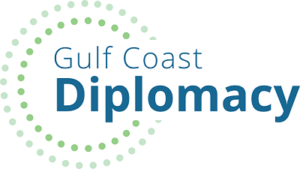On September 28th four visitors from Australia arrived in Pensacola as part of an U.S. Department of State International Visitor Leadership Program project titled Modern Communities: Efficient Engineering and Resource Management. The purpose of the project was “to explore green building standards certification systems, examine construction industry trends, assess the economic effect of environmentally friendly development, learn how current community development integrates green design, and examine the social aspects of community planning.”
As part of their introduction to Pensacola, the group walked through downtown Pensacola while discussing urban development with Steve Dana (Senior Design Associate / Landscape Architect). Another appointment similar to this one involved Gulf Coast Citizen Diplomacy Council staff member Jenny Savely, a PhD Candidate in Sociology/Community and Economic Development, where the visitors took a driving tour of Pensacola neighborhood developments to discuss the social impact of development policies and observe communities where such effects are disparate.
When they arrived at Pensacola City Hall for their orientation, City Council Executive Don Kraher welcomed them while sharing an overview of the city’s history and highlighting the functions of city government. This was complimented by a meeting with attorney Erick Meade and Building Inspector Bill Weeks, representatives of the City of Pensacola’s Architectural Review Board which focuses on planning, preservation, and inspection. This board helps preserve and protect the architectural integrity of buildings in the city’s five historic and preservation districts: Pensacola Historic District, North Hill Preservation District, Old East Hill Preservation District, Palafox Historic Business District, and Governmental Center District.
In an effort to provide the visitors with an overview of Pensacola’s tourism industry and to discuss advertising and promotional strategies for coastal and beach tourism, the group met with Steve Hayes, Vice President of Tourism, at Visit Pensacola. Visit Pensacola is the destination marketing organization promoting Pensacola and its surrounding areas as an attractive location for meetings, conventions, and leisure tourism. Afterwards, they met with Dr. Zhiyong Hu of the Earth and Environmental Sciences Department at the University of West Florida for an overview of how to statistically capture urban development and their outcomes.
Next, the Australians met Public Information Officer Jim Roberts for site visits to the Escambia County Utilities Authority recycling facility at the Perdido Landfill and to the Central Wastewater Reclamation Facility, a state-of-the-art facility which at $316 million is the largest public works project in the history of Escambia County. It was built to withstand hurricane force winds up to 190-mph and uses a highly developed biological treatment and disinfection process to clean water and provide up to 17 million gallons a day of reclaimed water to the local electrical plant and up to six million gallons a day of reclaimed water to a nearby paper mill.
To incorporate environmental protection and a public-private environmental partnership into the project, the Australians had an engaging meeting with Escambia County Water Quality Laboratory Manager Christy Draper and Environmental Technician Mollie Taylor. They also took two site visits and discussed the county’s land development code with Development Services Division Manager Andrew D. Holmer to explore land use regulations encompassing a diverse range of environments, including coastal and beach areas, built up urban zones, low density rural land, and forested natural areas.
The Gulf Coast Citizen Diplomacy Council thanks everyone who made this project a success, including the Diplomacy Council Young Professionals who held an afterhours networking social for the group one evening.

